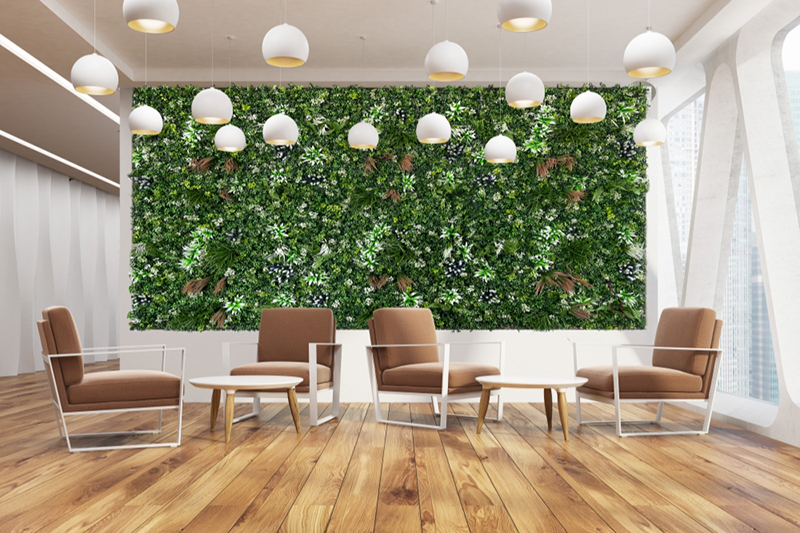Effective drainage is critical for the health and longevity of 3D artificial vertical gardens, as poor water management can lead to root rot, mold growth, and structural damage. A well-designed drainage system ensures optimal moisture levels, prevents waterlogging, and maintains plant vitality. This article explores key considerations for drainage setup, including material selection, slope design, and maintenance practices.
The foundation of a vertical garden’s drainage system lies in its drainage layer, which facilitates water flow and prevents water accumulation. Common materials used for this layer include lightweight aggregates, such as expanded clay pellets or perlite, which create air pockets and improve aeration. These materials also allow excess water to drain freely while retaining some moisture for plant roots.
In addition to aggregates, geotextile fabrics are often integrated into the drainage layer to prevent soil or substrate particles from clogging the system. The fabric acts as a filter, ensuring water passes through while retaining fine particles that could otherwise block drainage channels. The thickness and composition of the drainage layer should be tailored to the garden’s size and plant requirements, with deeper layers needed for larger installations or moisture-loving species.
Proper slope design is essential for directing water away from the vertical garden and preventing pooling. The garden’s surface should be angled slightly to encourage gravity-driven water flow toward drainage outlets. For example, a gentle slope of 1–2% is often sufficient to ensure efficient drainage without compromising the garden’s aesthetic or structural integrity.
In installations where natural slope is not feasible, such as on flat building facades, artificial grading can be achieved using modular panels with built-in channels or by adjusting the mounting frame. Additionally, ensuring that drainage outlets are positioned at the lowest points of the garden helps collect and redirect water to appropriate discharge points, such as gutters or storm drains.
Even with a well-designed drainage system, overflow can occur during heavy rainfall or irrigation malfunctions. Incorporating overflow mechanisms, such as weep holes or secondary drainage channels, prevents water from spilling over the garden’s edges and causing damage to surrounding surfaces. These overflow points should be strategically placed to handle excess water without compromising the garden’s stability.
Runoff management is another critical aspect. Water discharged from the vertical garden should be directed to safe areas, away from building foundations or pedestrian pathways. In some cases, runoff can be harvested for reuse in irrigation, reducing water waste and promoting sustainability. However, this requires additional filtration to remove contaminants before reuse.
The drainage system must work in tandem with the irrigation setup to maintain balanced moisture levels. Drip irrigation is often preferred for vertical gardens, as it delivers water directly to the root zone and minimizes surface runoff. The irrigation system should be designed to complement the drainage layer, ensuring that water is applied evenly and that excess is promptly removed.
Moisture sensors can be integrated into the garden to monitor soil moisture and adjust irrigation schedules dynamically. This prevents overwatering, which can overwhelm the drainage system, and underwatering, which can stress plants. Additionally, ensuring that irrigation lines are properly sealed and free of leaks prevents water from bypassing the drainage layer and causing localized saturation.
Regular maintenance is crucial for sustaining the effectiveness of the drainage system. Clogs in drainage channels or geotextile fabrics can reduce water flow and lead to standing water. Inspecting the drainage layer for debris, algae growth, or sediment buildup should be part of routine maintenance. Cleaning the system with a gentle stream of water or compressed air can restore functionality without damaging components.
Checking the integrity of overflow mechanisms and runoff pathways is equally important. Damaged weep holes or blocked discharge points can cause water to back up, risking plant health and structural damage. Additionally, monitoring the garden’s moisture levels and adjusting irrigation as needed ensures that the drainage system operates within its designed capacity.
Designing an effective drainage system for 3D artificial vertical gardens requires careful consideration of materials, slope, overflow management, and irrigation integration. By prioritizing these elements and implementing regular maintenance protocols, stakeholders can ensure that vertical gardens remain healthy, functional, and free from water-related issues. As vertical gardens become more prevalent in urban environments, robust drainage systems will be essential to their success and sustainability.

Contact: Amy
Phone: 86-15311787313
E-mail: info@foszmac.com
Whatsapp:86-15311787313
Add: Fengtai District, Dacheng Road, No.24 Building, Room 203, Beijing, China